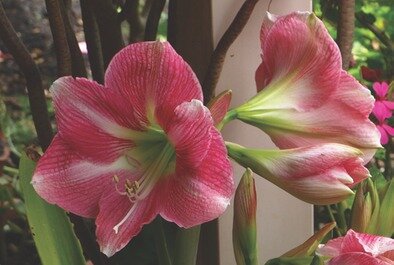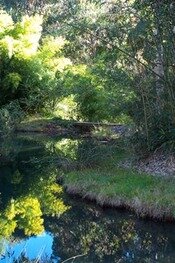Almond blossom

The almond tree with its early spring blossom is literally a classical plant growing in the Mediterranean regions for millennia.
Call them traditional plants or the plants that grandmother used to grow, but there are a number of plants ranging from large trees to small shrubs and, indeed, bulbs which are the great survivors and performers in our mediterranean-climate gardens.
Novice or highly experienced gardeners can select from these types of plants knowing that they will get good garden performance with not too many problems, nor much effort. Not surprisingly the origins of these plants are from climes similar to our own and they are designed to handle the long periods of our dry summer and give us flowers or fruit, and even colour and perfume.
So which plants make the top of the list for performance and reliability? Here are a few to start you thinking - I am sure you will add your own favourites.
The black or Persian mulberry, Morus nigra, is a top plant and from late December and into January it is resplendent with its inimitable fruits. Eaten fresh straight from the tree (and very hard to disguise the fact that you’ve been picking them) they are delicious. If you can refrain from eating them as you pick them, and can gather them in sufficient quantities, they make a beautiful jam or are delicious in tarts.
Whilst a young tree will require watering over the first few summers, once established on deep soils, they will grow with little attention into massive trees that with age will sprawl gently across a paddock, still continuing to produce fruit even after a century. The leaves are well known for providing food for silkworms and thus have a place not only in our gardens but as part of our human history.
Another tree with classic origins is the almond, Prunus dulcis, also a sturdy performer in the garden and, as well as producing one of the best of the nuts, is known as the harbinger of spring. Its blossoms are some of the first to flower in late winter, early spring. They have an elegant beauty - pink buds opening to a pale pink fading to white, five-petalled flowers of a simple form, appearing before the leaves.
The tree is deciduous with the leaves dropping toward the end of summer as a water-saving tactic if the season is particularly dry. Probably a native of western and temperate India and Iran it spread into what is now Israel some four thousand years ago. Later it became well known in southern and middle Europe arriving in Britain some 400 years ago. It was one of the first of the nut trees to be brought to the Swan River Settlement and arrived by the 1830s. It is one of my favourite trees, well worth a place in our gardens even though we can rarely enjoy the almonds. Twenty-eight parrots invariably beat us to the crop.
The spring-flowering rose that resembles a puff of fairy floss with its frilly pink and white petals is often found around old settlements of the South West. It is Rosa indica-major, possibly grown as a stock rose, but also is a pretty rose in its own right. It has long, arching canes with flowers covering the branches in spring.
The fact that this rose survives long after the old homesteads are gone is testament to its toughness. It will grow readily from cuttings, and whilst not usually available from nurseries can often be sourced through friends. This Rosa indica-major is but one of many that perform well in the gardens of the central South West. The low humidity of summer ensures that the shrubs have fewer fungal diseases than in areas with summer rain.
This short list would be incomplete without mention of at least one of the spring-flowering bulbs. Best grown as a veranda plant the Hippeastrum is a type of lily with some resemblance to the Bella Donna lilies, but in a different genus. It is best left to become dormant and slightly dry over winter and protected from severe frost. In spring it produces heads of classically shaped lily flowers in colours ranging from red through pink to white with variations in between. A most rewarding plant with many hybrids, its large flowers are a wonderful sight in a pot near the front door.
We could add many more rewarding plants to this list, such as the fig, the carob, the Chinese elm, the oaks, but the plants described above are a start. They are on the whole easy to grow, do not require heaps of water and are of low inflammability; they are garden stalwarts.




